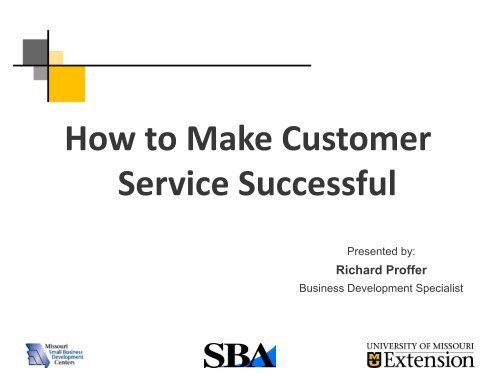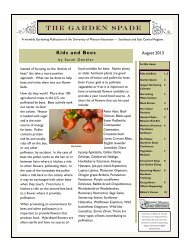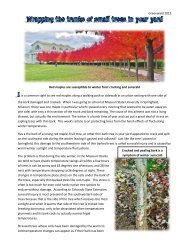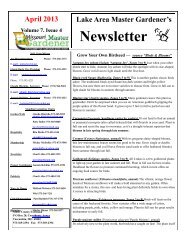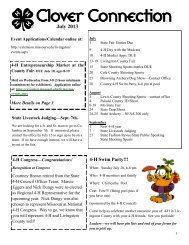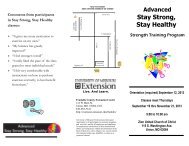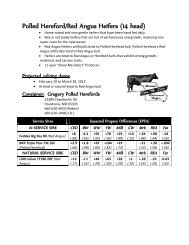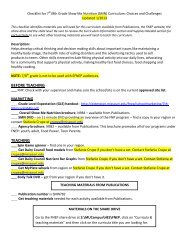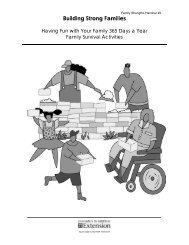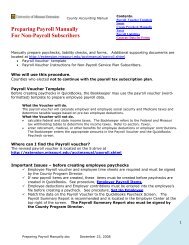How To Make Customer Service Successful Powerpoint
How To Make Customer Service Successful Powerpoint
How To Make Customer Service Successful Powerpoint
Create successful ePaper yourself
Turn your PDF publications into a flip-book with our unique Google optimized e-Paper software.
<strong>How</strong> to <strong>Make</strong> <strong>Customer</strong><br />
<strong>Service</strong> <strong>Successful</strong><br />
Presented by:<br />
Richard Proffer<br />
Business Development Specialist
• Cell phones/pagers<br />
• Restrooms<br />
• Breaks<br />
• Respect<br />
• Interactive process<br />
Housekeeping
Sponsors<br />
Bringing research based educational<br />
programs to the local community<br />
Improving people’s lives and the<br />
competitiveness of Missouri businesses<br />
through research based education and<br />
technical assistance to enhance Missouri’s<br />
economy<br />
Helping America’s small businesses prosper<br />
and working to improve the environment so<br />
they can survive
• Participants<br />
– Name<br />
– Company<br />
– Position<br />
– Desired Outcome<br />
• Me<br />
Who are You?
<strong>To</strong>day’s Agenda<br />
• <strong>Customer</strong> <strong>Service</strong> what is it?<br />
• <strong>How</strong> do I handle customer service?<br />
• Greetings<br />
• Needs Analysis<br />
• Get Talking to Each Other<br />
• Recovery
Outcomes<br />
• Enhanced self awareness<br />
• <strong>Customer</strong> behaviors<br />
• Introduce new/review skill sets<br />
• <strong>How</strong> to handle customers at<br />
different levels of satisfaction<br />
• Signature <strong>Service</strong>
<strong>Customer</strong> <strong>Service</strong> –<br />
What is it?
What is <strong>Customer</strong> <strong>Service</strong>?<br />
• “the ability of an organization to constantly<br />
and consistently give the customer what they<br />
want and need.”<br />
– Doug Horwell, president ACA Group<br />
• “Organizations exceed customer expectations<br />
by focusing improvement efforts in three<br />
areas: customer friendly processes, employee<br />
commitment to customer service & customer<br />
dialog.” - Eberhard Scheuing, author Creating <strong>Customer</strong>s for Life
Why <strong>Customer</strong>s Leave You…<br />
• 1% die<br />
• 3% move away<br />
• 5% just do<br />
• 9% competition outdoes you<br />
• 14% product/service dissatisfaction<br />
• 68% perception of poor attitude of customer<br />
service staff or person the customer interacted<br />
with
Lost <strong>Customer</strong>s<br />
• It costs five or six times more to acquire a new<br />
customer than it does to retain a current<br />
customer.<br />
• You lose the revenue their business would have<br />
provided in the time it takes you to replace them<br />
with a new customer.
<strong>How</strong> we Unintentionally offend our<br />
<strong>Customer</strong>s<br />
• See Handout – group activity.
What Offends Your <strong>Customer</strong>s?<br />
• Employees who…<br />
– Fail to acknowledge<br />
– Hover<br />
– Do not listen<br />
– Do not know the merchandise<br />
– Do not know store policies<br />
– Are verbally abusive<br />
– Use negative body language<br />
– Are unfriendly
What Offends Your <strong>Customer</strong>s?<br />
• Employees who…<br />
– Are not dressed neatly<br />
– Are crabby<br />
– Fail to keep their word or lie<br />
– Do poor quality work<br />
– Argue<br />
– Are rude in person or telephone<br />
– Won’t make adjustments for unsatisfactory merchandise<br />
or service<br />
– Indicate that they do not care
Why do <strong>Customer</strong>’s Come to YOU<br />
• “more customers make their decision to buy<br />
based on the salesperson than any other<br />
single factor in the sale including the price,<br />
quality and comprehensiveness of the<br />
solution.”<br />
– H.R. Chally Group study, “Selling Power” July/Aug 2006
What does this mean to you?<br />
• Increased flexibility on the job<br />
• Higher degree of accountability to your<br />
customers<br />
• Daily exceeding your customer’s expectations<br />
• Higher degree of personalized care based on<br />
each customer’s needs
-OR-<br />
Higher<br />
Level<br />
Of<br />
<strong>Customer</strong><br />
<strong>Service</strong>
Common Sense <strong>Customer</strong> <strong>Service</strong><br />
RESULTS!!!<br />
Increased satisfied customers<br />
Increased employee productivity<br />
Increased business profits
Why do this?<br />
• Increased competition<br />
• <strong>Customer</strong>’s satisfaction level can decrease<br />
• Fewer prospective customers considering<br />
• People talk to one another
• Why we remember…<br />
– Especially pleasing<br />
– Cost little or nothing<br />
We Remember…<br />
– Take little or no extra time<br />
– Sets you and your<br />
employer/community apart<br />
– Personalized<br />
• This happens when…<br />
– You are paying close<br />
attention to the<br />
person(s) you are<br />
dealing with<br />
– Committed to achieving<br />
satisfaction<br />
– Easy to deal with<br />
– Willing to sign your<br />
name to your work
Types of <strong>Customer</strong>s<br />
• Comfortable<br />
– Need appreciation<br />
– May not be satisfied<br />
• Indecisive<br />
– Need reassurance and clarity<br />
• Insistent<br />
– Need action ASAP<br />
• Irate<br />
– Need validation of emotions
<strong>How</strong> do I handle<br />
<strong>Customer</strong> <strong>Service</strong>?
Individuals<br />
• Handle situations differently<br />
• Think differently<br />
• Process differently<br />
• Recognize differently
4 Fears<br />
• Mistakes<br />
– I must always be right I am informed<br />
– Develop an attitude of growth and learning<br />
• Rejection<br />
– I must be liked I am helpful<br />
– My self worth is not based on number of people<br />
who like me
• Failure<br />
4 Fears<br />
– I must always win I am confident<br />
– Create win-win situations<br />
• Pain<br />
– I must be comfortable I can adjust<br />
– Discomfit is temporary and I can adjust
<strong>How</strong> Overcome?<br />
• Stop<br />
– Stop the conversation<br />
– Breathe deep<br />
• Challenge<br />
– What am I feeling/telling myself mentally?<br />
– Is it an accurate reflection of situation?<br />
• Focus<br />
– What do I want to happen?<br />
– <strong>How</strong> can I make it happen?
Greetings
• Pleasant/Friendly<br />
• Conversant<br />
• Relaxed<br />
• Cooperative<br />
Comfortable <strong>Customer</strong>s<br />
• Greeting<br />
– Appreciation<br />
– You deserve<br />
– Glad you are telling me<br />
this…<br />
– We blew it<br />
– Ask for satisfaction
• Insulting<br />
• Intimidating<br />
• Confronting<br />
• Argumentative<br />
Irate <strong>Customer</strong>s<br />
• Greeting<br />
– Ok to be angry<br />
– Listen to customer<br />
– Let customer vent<br />
– Work to understand<br />
– Help resolve<br />
– Ask for satisfaction
• Assertive<br />
• Demanding<br />
• Directive<br />
• Abrupt<br />
Insistent <strong>Customer</strong>s<br />
• Greeting<br />
– Do what customer asks if<br />
appropriate ASAP<br />
– Handle now<br />
– Communicate your<br />
urgency to resolve<br />
situation<br />
– Ask for satisfaction
• Puzzled<br />
• Hesitant<br />
• Apprehensive<br />
• Avoiding<br />
Indecisive <strong>Customer</strong>s<br />
• Greeting<br />
– Reassure<br />
– Clarify<br />
– Stay with them until<br />
needs are met<br />
– Ask for satisfaction
The Process<br />
• Recognize the degree of satisfaction<br />
• Establish a conversation<br />
• Determine the customer’s needs by asking<br />
• Listen to them<br />
• Personalize your response<br />
• Ask for satisfaction<br />
• Repeat till customer is satisfied
Needs<br />
Analysis
Needs vs. Wants<br />
• Needs are “got to have” items<br />
• Wants are “nice to have” items
Needs, Wants & Expectations<br />
• Ask customers what they need and want from<br />
you.<br />
• Ask them what they expect from you. You<br />
can’t meet or exceed their expectations if you<br />
don’t know what they are.
Meeting Your <strong>Customer</strong>’s Needs<br />
• Do you know the needs, wants and<br />
expectations of your customers?<br />
YES OR<br />
NO
<strong>Customer</strong> Needs/Expectations<br />
• Three things your interaction is mentally<br />
graded on by your customers<br />
– Did I receive the minimum service I thought I<br />
should?<br />
– Did I get more of what I wanted or hoped for?<br />
– Did I get anything I did not want or feared might<br />
happen?
<strong>Customer</strong> Needs/Expectations<br />
YOU should have a basic answer for each<br />
of those questions after your interactions<br />
with your customers.
Get Talking<br />
to Each Other
Explanations<br />
• Repeat your understanding of the customer’s<br />
needs/expectations<br />
• Personalize<br />
• Check for clear understanding<br />
• Tell them what you are going to explain to them (policy,<br />
procedure, product, service)<br />
• Explain why they want or need to know<br />
• Explain your answer to the need/expectation<br />
• Ask for satisfaction
When You Can’t Meet…<br />
• Want to keep your customer’s satisfied with<br />
your conversation<br />
• Explain why you are saying “no” is to their<br />
benefit<br />
• Tell them what you can do instead of “NO”<br />
and offer options to help resolve related<br />
issues<br />
• Ask for satisfaction (realize you may not get it)
In All Instances…<br />
• Personalize the conversation<br />
• <strong>To</strong>uch them appropriately (if possible)<br />
• Recognize them as a person not a number<br />
• <strong>Make</strong> eye contact (where possible)<br />
• Offer options<br />
• Thank them for being a customer<br />
• Use your name<br />
• Be genuine
Recovery
• 5 A Program<br />
– Acknowledge<br />
– Apologize<br />
– Accept<br />
– Adjust<br />
– Assure<br />
Recovery Steps
Other applications<br />
• Phone calls from customers<br />
• Public settings<br />
• Email<br />
• Internet
Review…<br />
MOST IMPORTANTLY…<br />
You Should<br />
Personalize<br />
the experience…
The <strong>Customer</strong>…<br />
• Is the most important person in my business<br />
• Does not depend on me – I depend on the customer<br />
• Is not an interruption to my work – the customer is the purpose of my<br />
work<br />
• Does me a favor when calling – I am not doing the customer a favor by<br />
being here<br />
• Is part of my business – not an outsider<br />
• Is a real person with feelings very much like me<br />
• Does not want to argue or match wits with me<br />
• Is a person who brings me his wants – it is my job to fill those wants<br />
• Deserves the best and most courteous service I can give<br />
• Is the one who makes it possible to pay me
• Please fill out<br />
• Honesty is desired<br />
Evaluation<br />
• Continual learning organization
For further questions<br />
Richard Proffer<br />
Business Development Specialist<br />
University of Missouri Extension<br />
Small Business Development Center<br />
Ph# 573-243-3581<br />
Email: profferrd@missouri.edu
Handouts<br />
• Reasons for Poor <strong>Customer</strong> <strong>Service</strong><br />
• <strong>Customer</strong> Pet Peeves<br />
• <strong>How</strong> to become more <strong>Customer</strong>-Oriented<br />
• <strong>Customer</strong> <strong>Service</strong> Excellence: It’s in the Details!<br />
• Tips to <strong>Customer</strong> Satisfaction<br />
• 10 Ways to Miscommunicate<br />
• Walk-in Greetings


